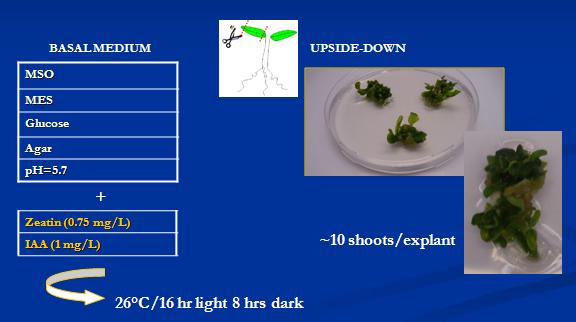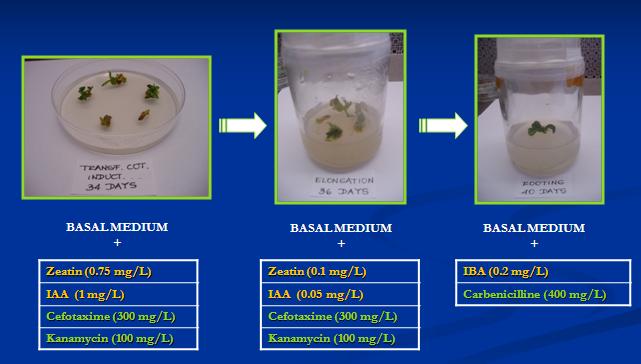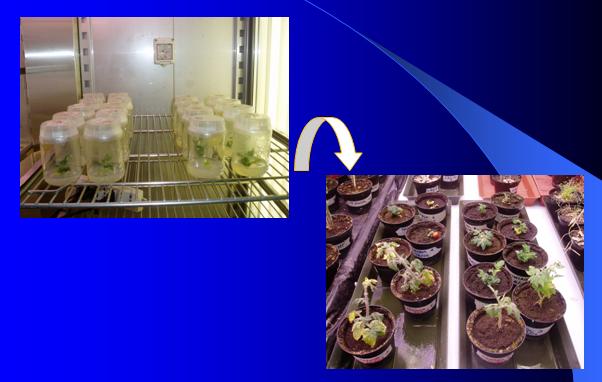A. Agroinfiltration of tomato fruits: transient expression system of foreign genes (Added by Diana Zuluaga and Giovanni Povero).
· Take bacterial culture using a 1 ml syringe with a 0.5 x 16 mm needle.
· Introduce the needle 3 to 4 mm in depth into the fruit tissue through the stylar apex and inject the infiltration solution gently into the fruit until some drops of infiltration solution begin to show running off the hydathodes at the tip of the sepals.
Note: For tomato leaf agroinfiltration, remove needle and introduce A. tumefaciens cultures in the intercellular spaces (Liu et al., 2002).
B. TOMATO STABLE TRANSFORMATION (Added by Diana Zuluaga and Giovanni Povero)
Plant material and growth conditions
Our tomato seeds are sowed in pots containing a peat-based substrate (Hawita Flor, Vechta, Germany). Plants are cultivated in the growth chamber for ~3 months with 80 mmolm-2 s-1 PAR, 16 h light photoperiod (GroLux, Sylvania, OH, USA), 24 °C temperature. In these conditions, plants begin to flower after ~40 days.

Cloning procedure and plasmid construction
For plant transformation we use a binary vector carrying the Cauliflower mosaic virus 35S promoter.
The gene of interest is then cloned by one-step RT-PCR, using the ‘Titan One Tube RT-PCR Kit’ (Roche Diagnostics, Mannheim, Germany).

Tomato transformation
For plant transformation, tomato seeds are surface-sterilised by immersion into a 4% (v/v) solution of sodium hypochlorite for 15 min and rinsed four times in sterile distilled water. Afterwards, they are placed on 25mL of half-strength MS medium (Murashige and Skoog 1962) (pH 5.7) containing 15 g L-1 sucrose and 7 g L-1 agar and incubated for 7 days at 24 °C for germination. Single colonies of Agrobacterium harbouring the vector are grown in 5mL of Luria-Bertani (LB) liquid medium with 200 mM acetosyringone overnight.
Cotyledon pieces (~0.25 cm2) are cut from tomato seedlings and soaked for 10 min in Agrobacterium liquid culture (OD600 nm = 0.5), and then placed on the co-cultivation medium consisting of MS containing 20 g L-1 glucose, 1mM MES, 0.75 mg L-1 trans-zeatin, 1.0 mg L-1 IAA, and 200 mM acetosyringone, pH 5.7, and incubated at 24 °C in the dark.
After 2 days, the cotyledon pieces are transferred to the induction medium (same composition of the co-cultivation medium plus 300 mg L-1 cefotaxime and 100 mg L-1 kanamycin sulfate, but without acetosyringone). Tissues are sub-cultured every 21 days until shoot formation, incubated at 24 °C under a 16 h light photoperiod with a light intensity of 80 mmolm-2 s-1. Once shoots begin to form, they are transferred to the elongation medium (same composition of the induction medium with 0.1 mg L-1 trans-zeatin and 0.05 mg L-1IAA) and incubated as above. Once shoots reach 2-4 cm in height, they are harvested and transferred to the rooting medium consisting of MS containing 20 g L-1 glucose, 1mM MES, 0.2 mg L-1 IBA and 400 mg L-1 carbenicillin.
Regenerated plantlets are finally transferred in soil and cultivated in pots in the growth chamber with light and temperature conditions as described above.
Single T0 transgenic plants are kept in the growth chamber until seed production. T1-generation plants from T0 individuals are grown to confirm the transgenic phenotypes.
